Shaded areas in your garden don’t have to be boring or lifeless. With the right plants, you can transform those dim spots into vibrant, lush havens. Whether you’re dealing with partial or deep shade, there are numerous plants that thrive without direct sunlight.
In this guide, we’ll walk you through the 20 Best Plants For Shade that will not only brighten up your garden but also flourish in areas where the sun’s rays can’t reach. From colorful foliage to delicate flowers, these shade-loving plants will add depth, texture, and life to your outdoor space.
Whether you’re looking for low-maintenance options or something unique, these 20 Best Plants For Shade are the perfect solution to create a thriving, beautiful garden in those tricky, darker spots. Let’s dive in and discover the best plants for shade that will bring your garden to life!
1. Hostas
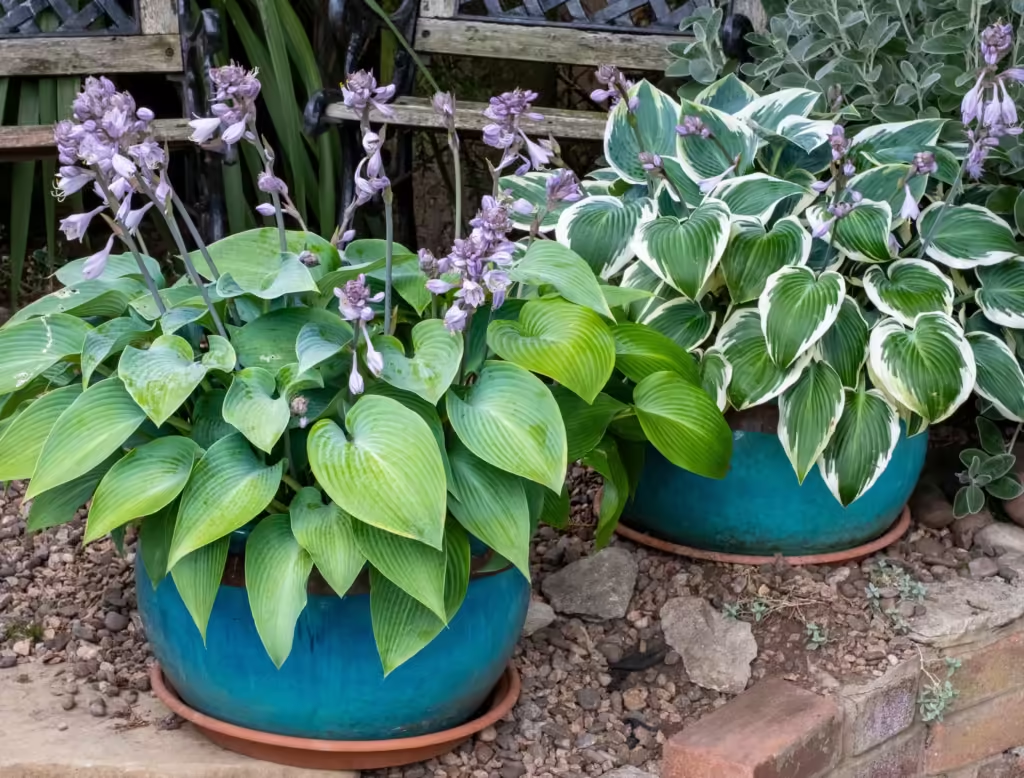
Known for their large and stunning foliage, hostas are the ultimate shade-loving plants. With varieties in shades of green, blue, and even variegated patterns, they bring texture and beauty to shaded garden beds. Hostas thrive in low-light conditions, making them an ideal choice for those looking to brighten up the darker areas of their garden. They are low-maintenance, resistant to pests, and their unique leaves add a soft elegance to any space. If you’re searching for plants that will truly stand out in shaded spots, hostas are definitely one of the 20 Best Plants For Shade you should consider for your garden.
Tips for Growing Hostas:
- Soil: Hostas prefer moist, well-drained soil that is rich in organic matter. Adding compost can help improve soil quality.
- Watering: While hostas love moisture, be sure not to overwater. Regular watering during dry periods will keep their foliage lush and vibrant.
- Protection from Wind: The large leaves of hostas are prone to damage from strong winds, so it’s best to plant them in sheltered spots.
- Divide Regularly: To keep your hostas healthy and thriving, divide them every few years. This encourages growth and prevents overcrowding.
Hostas are a versatile and beautiful addition to any shaded garden, making them a must-have for the 20 Best Plants For Shade list.
2. Ferns

Ferns are an excellent choice for shade gardens, known for their delicate, lacy fronds that add a touch of elegance and softness to any space. These versatile plants thrive even in areas with low light, making them perfect for those shaded spots that other plants might struggle with. Varieties such as the Japanese Painted Fern and Maidenhair Fern are particularly stunning, offering unique textures and colors that can brighten up any dim corner. Ferns also have a natural air-purifying quality, which makes them a great option for indoor shade as well.
Tips for Growing Ferns:
- Soil: Ferns prefer moist, well-drained, and slightly acidic soil. Adding mulch around the base will help retain moisture and keep their roots cool.
- Watering: Keep the soil consistently moist, but not soggy. Ferns are sensitive to drought, so be sure to water them regularly, especially during warmer months.
- Humidity: Ferns love humidity, so consider placing them near a water feature or misting them regularly, especially in indoor spaces.
- Temperature: They thrive in cool to moderate temperatures, making them perfect for shaded spots in your garden or home.
Whether you choose the graceful Japanese Painted Fern or the timeless Maidenhair Fern, these plants are definitely among the 20 Best Plants For Shade that will bring texture and charm to your shaded garden or home.
3. Astilbes
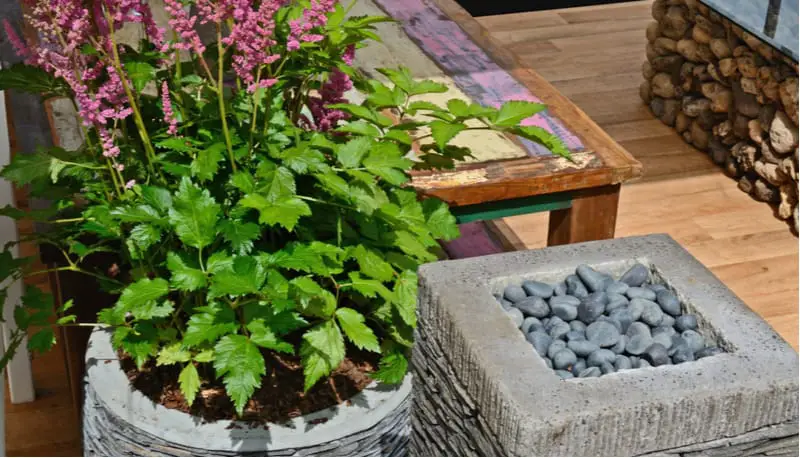
Astilbes are a fantastic choice for adding vibrant color and texture to shaded garden spaces. These perennial beauties produce feathery plumes in shades of pink, red, and white, creating a striking contrast against their dark green, fern-like foliage. Astilbes thrive in moist, shaded areas, making them ideal for those spots where other plants might struggle. Whether planted in garden beds, borders, or containers, Astilbes provide a stunning pop of color in even the shadiest corners of your garden.
Tips for Growing Astilbes:
- Soil: Astilbes thrive in rich, moist, and well-drained soil. To ensure the best growth, amend your soil with organic matter such as compost.
- Watering: These plants love moisture, so it’s important to keep the soil consistently moist, especially during dry spells. A layer of mulch around the base will help retain moisture and keep roots cool.
- Sunlight: While Astilbes prefer shade, they can tolerate some morning sun. However, too much direct sunlight can cause the leaves to scorch.
- Spacing: Astilbes can grow quite large, so be sure to space them adequately to avoid overcrowding. This also allows their vibrant blooms to fully show off.
Astilbes are a great way to add stunning visual interest and color to your shade garden, making them a must-have for anyone searching for the 20 Best Plants For Shade that thrive in low-light conditions.
4. Bleeding Heart
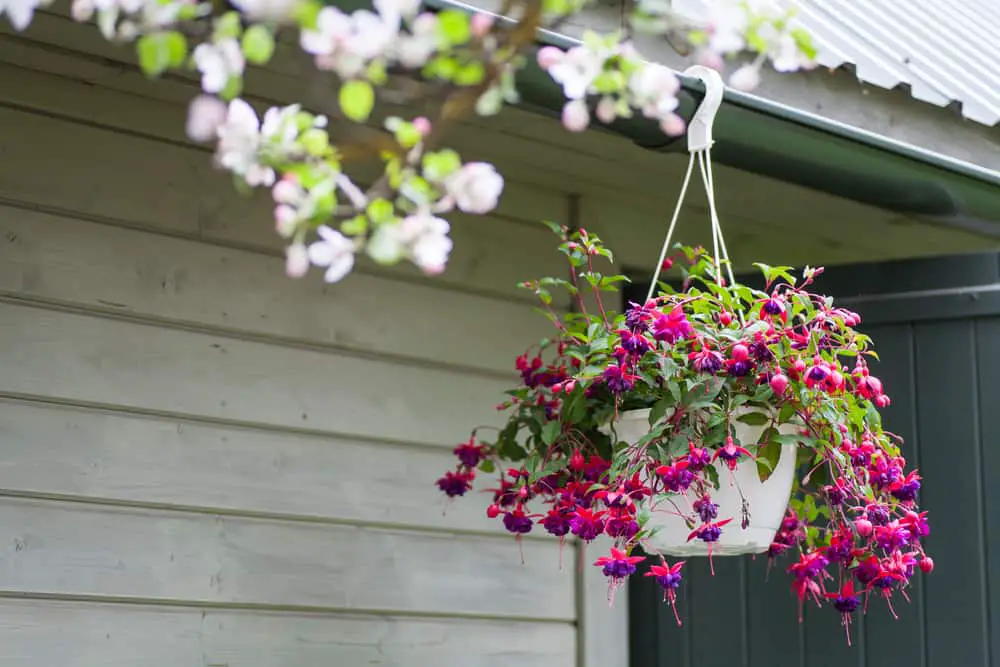
Add a romantic touch to your garden with the heart-shaped blooms of the Bleeding Heart plant. Known for its graceful, pendulous flowers in shades of pink or white, this perennial thrives in shady areas and is especially beautiful in the spring. The unique, delicate flowers resemble a “bleeding heart,” making it a standout in any shaded garden or woodland setting. Its fern-like foliage provides additional texture, creating a lush and whimsical look. Whether planted along garden borders or in shaded flower beds, the Bleeding Heart adds a charming and romantic element to your landscape.
Tips for Growing Bleeding Heart:
- Soil: Bleeding Hearts prefer moist, well-drained soil rich in organic matter. Adding compost will help improve the soil’s texture and provide the nutrients needed for healthy growth.
- Watering: Keep the soil consistently moist, but avoid waterlogging. Bleeding Hearts don’t like dry conditions, so regular watering is essential, especially in hotter months.
- Sunlight: While this plant loves shade, it can tolerate some morning sun. However, too much direct sunlight, especially in the afternoon, can scorch the leaves.
- Cut Back After Blooming: Once the Bleeding Heart has finished blooming, trim back the plant to tidy up the garden and encourage fresh growth.
With its romantic charm and striking blooms, the Bleeding Heart is a must-have for those looking to add unique beauty to their shaded garden. It’s certainly one of the 20 Best Plants For Shade that will thrive in the lower-light areas of your outdoor space.
5. Heuchera (Coral Bells)
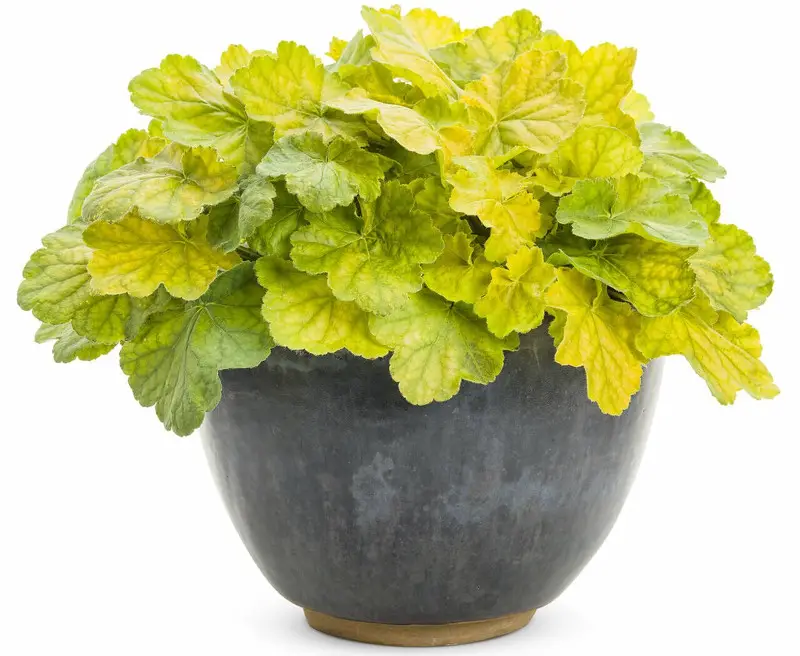
Heucheras, also known as Coral Bells, are a fantastic way to add a vibrant splash of color to your shaded garden. Known for their striking foliage, Heucheras come in a wide range of colors, from deep burgundy and purple to bright lime green and even metallic shades. These plants are perfect for creating contrast and visual interest in shady spots, where their foliage can truly shine. While they do produce small, bell-shaped flowers in late spring to early summer, it’s their stunning leaves that steal the show. Whether used as ground cover or in containers, Heucheras are a must-have for anyone looking to brighten up a shaded area.
Tips for Growing Heuchera:
- Soil: Heucheras prefer well-drained, slightly acidic soil. They will thrive in soil that’s rich in organic matter, so adding compost can help improve both drainage and nutrient content.
- Watering: These plants like moist soil, but be sure not to overwater. Allow the soil to dry slightly between waterings, especially in areas with more rain.
- Sunlight: Heucheras are adaptable, but they do best in partial to full shade. Too much direct sunlight can cause their vibrant foliage to fade, so it’s important to plant them in a shaded or dappled light location.
- Mulching: A layer of mulch will help keep the roots cool, retain moisture, and protect the plants from temperature extremes.
With their bold colors and versatile nature, Heucheras are a standout choice among the 20 Best Plants For Shade and a great addition to any garden in need of a touch of elegance and vibrancy.
Related Topics:
6. Lungwort

Despite its less-than-flattering name, Lungwort is a true gem for shade gardens. Known for its striking spotted or silvery leaves, Lungwort adds a unique texture to any shaded area. The plant produces clusters of small, bell-shaped flowers in shades of pink, blue, or purple, which bloom in early spring, bringing a welcome pop of color to low-light spaces. Lungwort thrives in partial shade, making it an ideal choice for those tricky areas where few other plants can flourish. Its ability to thrive in both the shade and cooler temperatures makes it a great addition to shaded garden beds, woodland areas, or as ground cover.
Tips for Growing Lungwort:
- Soil: Lungwort prefers moist, well-drained soil with a slightly acidic to neutral pH. Enriching the soil with organic matter will promote healthy growth and vibrant flowers.
- Watering: Keep the soil consistently moist, but avoid waterlogging. Lungwort doesn’t like dry conditions, so regular watering is key to maintaining its health, especially in warmer weather.
- Sunlight: Lungwort does best in partial shade, where it receives a bit of morning sunlight but is protected from harsh afternoon rays. Too much direct sunlight can scorch its leaves.
- Mulching: A layer of mulch around the base will help retain moisture and keep the roots cool during hot weather.
With its beautiful foliage and colorful blooms, Lungwort is a must-have for any shaded garden. It’s definitely one of the 20 Best Plants For Shade and a unique, low-maintenance option for adding charm to shaded spaces.
7. Brunnera (Jack Frost)
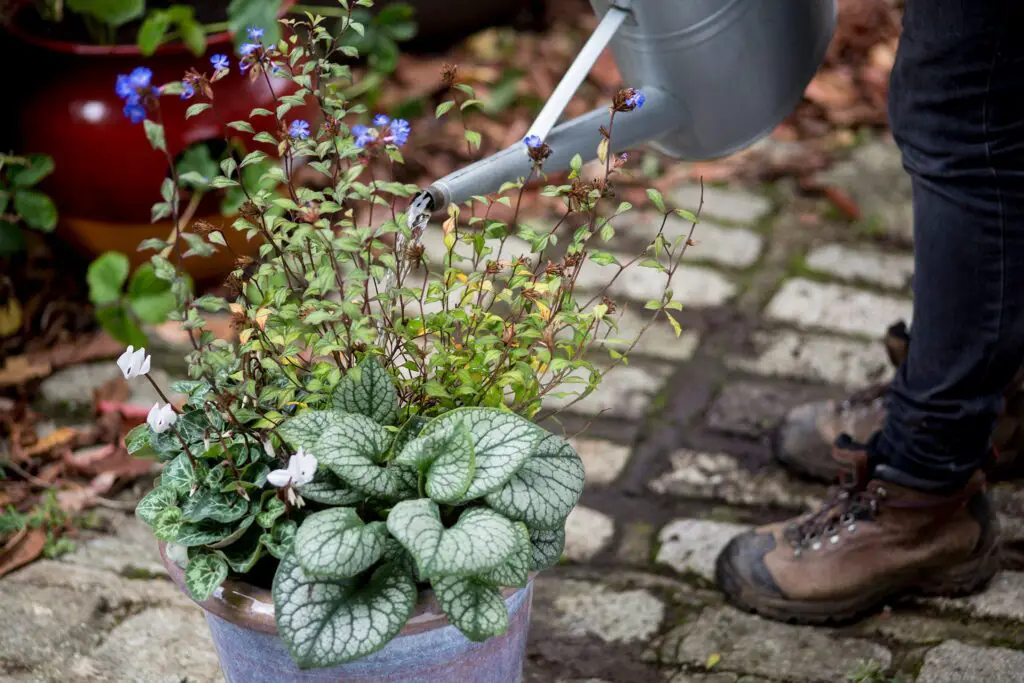
Brunnera, commonly known as Jack Frost, earns its nickname thanks to its stunning silvery, frost-like leaves that catch the light and brighten any shaded garden. These heart-shaped leaves are adorned with intricate veins, creating a lovely, textured effect throughout the growing season. In early spring, Brunnera produces charming blue flowers that resemble delicate forget-me-nots, adding a splash of color to low-light areas. Perfect for partial to full shade, Brunnera is an excellent choice for bringing both color and contrast to shaded spots in your garden.
Tips for Growing Brunnera (Jack Frost):
- Soil: Brunnera thrives in moist, well-drained soil that’s rich in organic matter. It enjoys slightly acidic to neutral soil, so be sure to amend it with compost for optimal growth.
- Watering: These plants prefer consistently moist soil, so regular watering is important. However, they don’t like soggy soil, so ensure good drainage to prevent root rot.
- Sunlight: Brunnera does best in partial to full shade, where it can flourish without the stress of direct sun. Too much sunlight can scorch its delicate foliage.
- Mulching: A layer of mulch will help keep the soil moist and cool, which is especially beneficial during hot spells.
With its shimmering leaves and charming blue blooms, Brunnera is undoubtedly one of the 20 Best Plants For Shade to add texture and color to shaded areas of your garden.
8. Japanese Forest Grass (Hakonechloa)
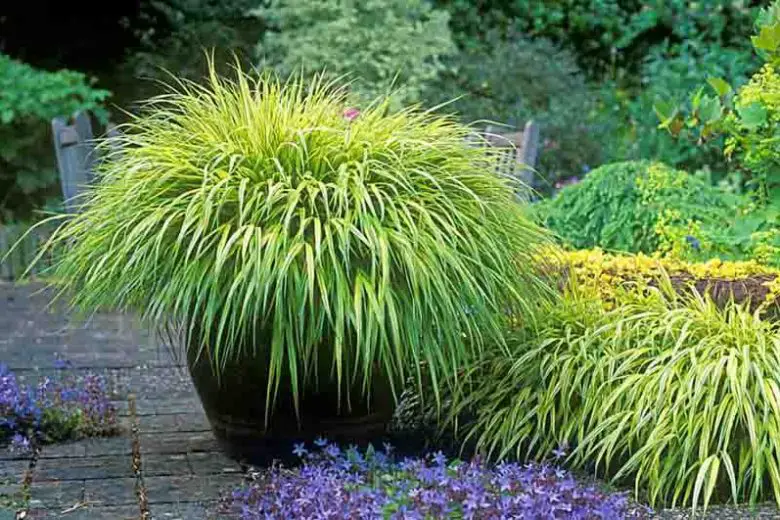
Japanese Forest Grass, also known as Hakonechloa, is a stunning ornamental grass that thrives in shaded areas. Its graceful, flowing blades bring a soft, cascading look to any garden, and it comes in a variety of shades, including lush green and striking golden yellow. Perfect for borders, edges, or even as ground cover, Hakonechloa adds a sense of movement and texture to shaded spaces. This grass is especially effective in creating a calming, natural aesthetic, making it a favorite for garden designers who want to bring a serene and sophisticated vibe to shady spots.
Tips for Growing Japanese Forest Grass:
- Soil: Hakonechloa thrives in moist, well-drained soil rich in organic matter. It prefers slightly acidic to neutral soil, so adding compost or organic mulch will help maintain healthy growth.
- Watering: Keep the soil consistently moist, especially during dry periods. Japanese Forest Grass doesn’t tolerate drought well, so regular watering is key to keeping it vibrant and healthy.
- Sunlight: While this ornamental grass thrives in partial to full shade, it can tolerate some morning sun. However, too much direct sunlight can cause its bright green or golden leaves to scorch.
- Spacing: Be sure to give it enough space to spread out, as it can form dense clumps. This makes it an excellent choice for creating borders, edges, or ground covers that can fill in areas naturally.
Japanese Forest Grass is one of the 20 Best Plants For Shade because of its beauty, versatility, and ability to thrive in low-light conditions. It’s a perfect addition to shaded gardens or areas where you want to create movement and visual interest.
9. Camellias
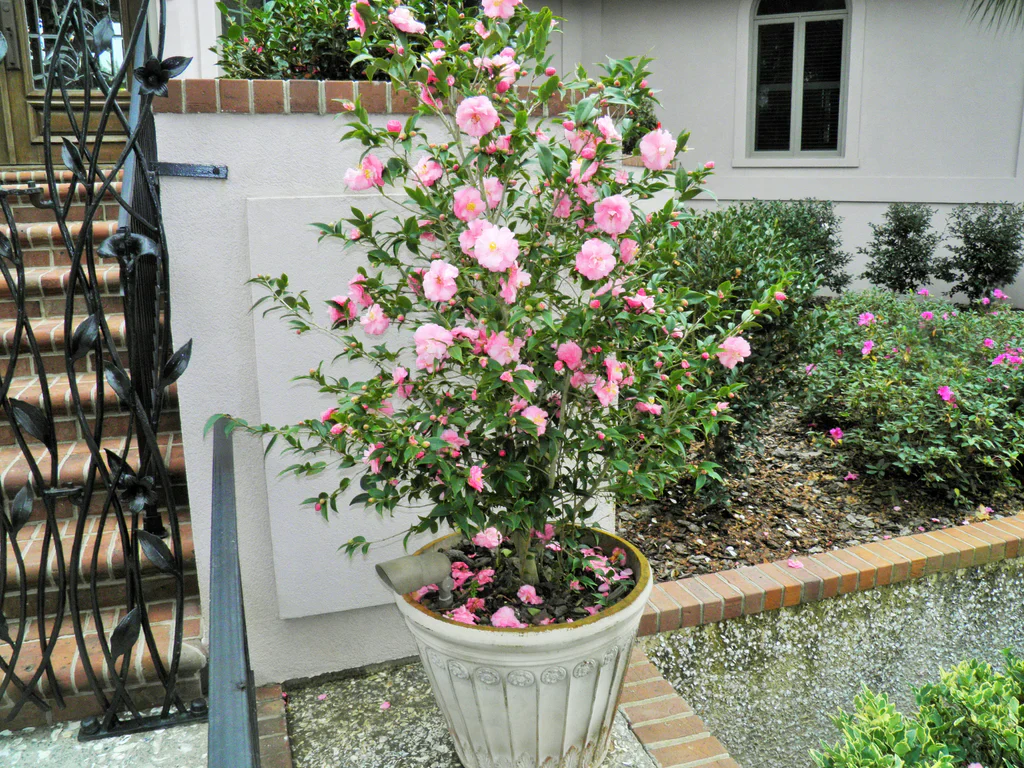
If you’re looking for winter blooms to brighten your shaded garden, Camellias are an excellent option. These evergreen shrubs produce beautiful, rose-like flowers in shades of pink, red, and white, offering a stunning contrast against their glossy green foliage. Camellias thrive in partial to deep shade, making them perfect for those areas where sunlight is limited. Not only do they provide year-round greenery, but their winter or early spring blooms bring much-needed color to otherwise dull, low-light spaces. With their elegant flowers and shiny leaves, Camellias are a classic addition to any shade garden.
Tips for Growing Camellias:
- Soil: Camellias prefer slightly acidic, well-drained soil that’s rich in organic matter. It’s best to amend your soil with compost to ensure healthy growth.
- Watering: Keep the soil consistently moist, especially during dry spells. Camellias are sensitive to drought, so regular watering is crucial, but be sure to avoid waterlogging.
- Sunlight: While Camellias prefer partial to deep shade, they can tolerate a bit of morning sun. However, too much direct sunlight can cause their leaves to scorch, so it’s important to plant them in a sheltered spot.
- Mulching: A layer of mulch around the base helps maintain moisture, keeps the roots cool, and protects the plant during colder months.
With their rich blooms and evergreen appeal, Camellias are undoubtedly among the 20 Best Plants For Shade, offering both beauty and resilience for your shaded garden.
10. Solomon’s Seal
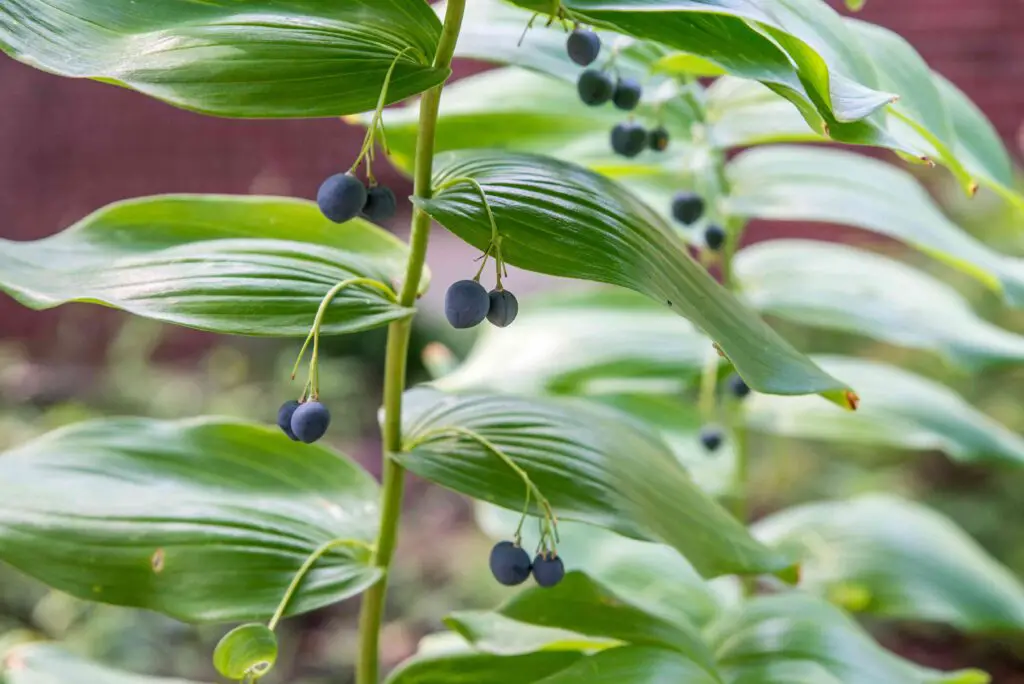
Solomon’s Seal is a truly elegant plant that thrives in shaded areas, offering both height and graceful beauty to your garden. Its arching stems, adorned with white, bell-shaped flowers, make it a striking addition to shaded garden beds and woodland gardens. The plant’s distinctive shape and subtle blooms create a sense of movement and texture, making it a wonderful choice for adding visual interest to low-light spaces. Solomon’s Seal is easy to grow and low-maintenance, making it perfect for gardeners looking to enhance their shaded spots with a touch of sophistication.
Tips for Growing Solomon’s Seal:
- Soil: Solomon’s Seal prefers well-drained, moist soil enriched with organic matter. It thrives in slightly acidic to neutral soil, so adding compost or mulch will encourage healthy growth.
- Watering: Keep the soil evenly moist, especially during dry spells, but avoid overwatering. Solomon’s Seal doesn’t like soggy soil, so ensure proper drainage.
- Sunlight: This plant thrives in full to partial shade, making it perfect for those harder-to-reach areas where sunlight is limited. It can tolerate some morning sun but should be protected from intense afternoon heat.
- Spacing: Plant Solomon’s Seal in clusters to create a natural, woodland look. It will spread over time, adding a lush layer to your shaded garden.
With its graceful form and stunning blooms, Solomon’s Seal is a must-have in your list of 20 Best Plants For Shade, offering height and elegance to shaded garden areas.
11. Trilliums

Native to woodlands, Trilliums are one of the most stunning and iconic flowers for shaded gardens. Their three-petaled flowers, which bloom in shades of white, pink, red, or purple, create a striking and elegant display in the spring. Trilliums are known for their distinctive flower shape and their ability to thrive in shaded, woodland-like conditions. They are particularly well-suited for creating a natural, serene garden setting and are a favorite among gardeners who want to highlight the beauty of spring in shaded spaces.
Tips for Growing Trilliums:
- Soil: Trilliums prefer rich, well-drained, and slightly acidic soil. They thrive in organic, moist soil, so be sure to add compost or leaf litter to mimic their natural woodland habitat.
- Watering: Keep the soil consistently moist, but not waterlogged. Trilliums are sensitive to drought, so it’s important to water regularly during dry spells, especially when they are actively growing in spring.
- Sunlight: Trilliums are perfect for full to partial shade and do not tolerate direct sunlight well. They naturally grow under the canopy of trees, so plant them in areas where they receive filtered light or dappled shade.
- Spacing: Plant Trilliums in clusters to replicate their natural woodland growth pattern. They will slowly spread, creating a beautiful and natural-looking ground cover in shaded garden areas.
With their unique and seasonal blooms, Trilliums are a standout choice among the 20 Best Plants For Shade. They bring beauty, color, and a woodland charm to any shaded space, especially during the spring months.
12. Coleus
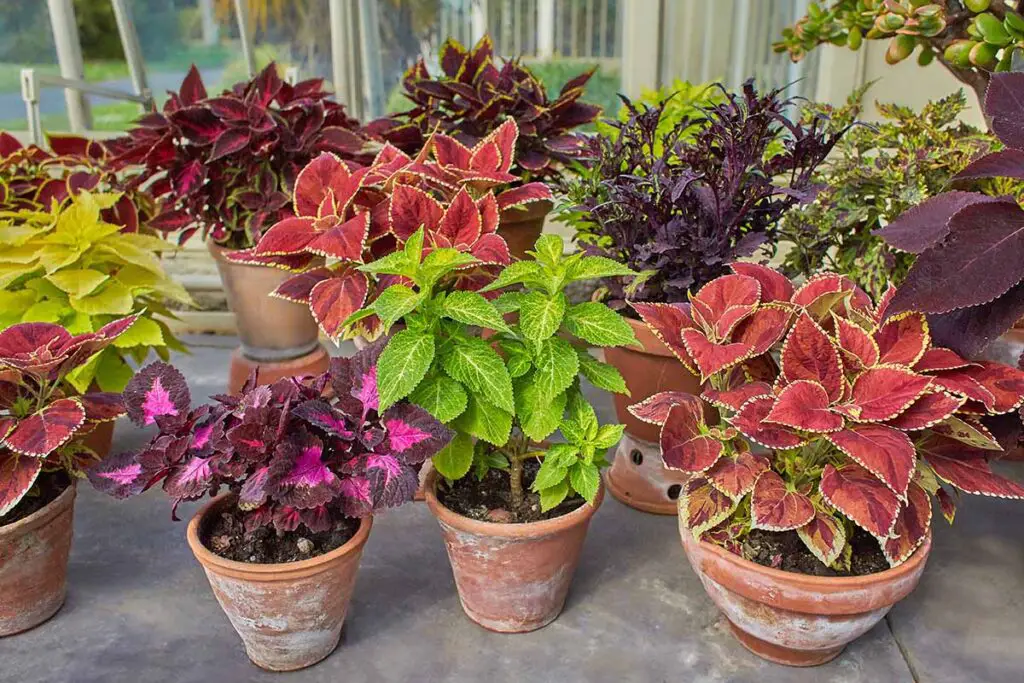
For gardeners seeking bold, colorful foliage, Coleus is a must-have. Known for its vibrant and intricate leaf patterns, Coleus offers an impressive array of colors ranging from deep reds and purples to bright yellows, greens, and even multicolored combinations. Perfect for partial shade, this annual plant adds instant drama to any garden, container, or hanging basket. Whether you’re looking to create eye-catching borders or fill in shady corners with a splash of color, Coleus is the ideal choice for those seeking vivid, low-maintenance foliage in shaded areas.
Tips for Growing Coleus:
- Soil: Coleus thrives in moist, well-drained soil. While they enjoy a rich, organic base, it’s important not to let the soil dry out. Regular feeding with a balanced fertilizer will also encourage healthy foliage.
- Watering: Keep the soil evenly moist. Coleus likes regular watering but can’t tolerate soggy soil, so ensure proper drainage. During hot weather, it’s important to water more frequently.
- Sunlight: While Coleus can tolerate some sunlight, it performs best in partial shade. Too much direct sunlight can scorch the leaves and cause the plant to lose its vibrant color. Filtered light or dappled shade is ideal.
- Pruning: Regular pruning will help the plant maintain a compact shape and encourage bushier growth. Pinch off any flowers that appear to focus energy on the foliage, which is the main attraction.
With its dazzling colors and ease of care, Coleus is an excellent addition to the 20 Best Plants For Shade. It’s perfect for adding brightness and texture to shaded gardens, creating a lively and vibrant atmosphere.
13. Hydrangeas

Hydrangeas are a favorite among gardeners for their large, showy blooms and ability to thrive in various conditions. While some varieties of Hydrangeas prefer more sunlight, certain types like Endless Summer and Annabelle do exceptionally well in shaded areas, making them ideal for bringing color and elegance to low-light spaces. These varieties produce big, beautiful blooms in shades of blue, pink, and white, adding a burst of color to your garden even in the shadiest corners. Hydrangeas are perfect for those who want to create a soft, romantic atmosphere in their shaded garden without sacrificing vibrant flowers.
Tips for Growing Hydrangeas:
- Soil: Hydrangeas prefer well-drained, rich soil that retains moisture. They thrive in slightly acidic to neutral soil, so adding organic matter like compost will help support healthy growth.
- Watering: Hydrangeas need regular watering, especially during the growing season. Keep the soil moist but not soggy. During dry spells, they will appreciate extra attention to ensure they stay hydrated.
- Sunlight: While they can tolerate some sunlight, Endless Summer and Annabelle varieties are particularly well-suited for partial or full shade. In too much direct sunlight, the flowers may wilt, and the foliage can suffer.
- Pruning: Hydrangeas bloom on old wood or new wood, depending on the variety. To encourage healthy blooms, prune the plants after the flowering season has ended or in early spring before new growth begins.
With their stunning blooms and ability to thrive in shade, Hydrangeas are a top contender among the 20 Best Plants For Shade. They offer both beauty and versatility, making them an excellent choice for any shaded garden.
14. Toad Lily
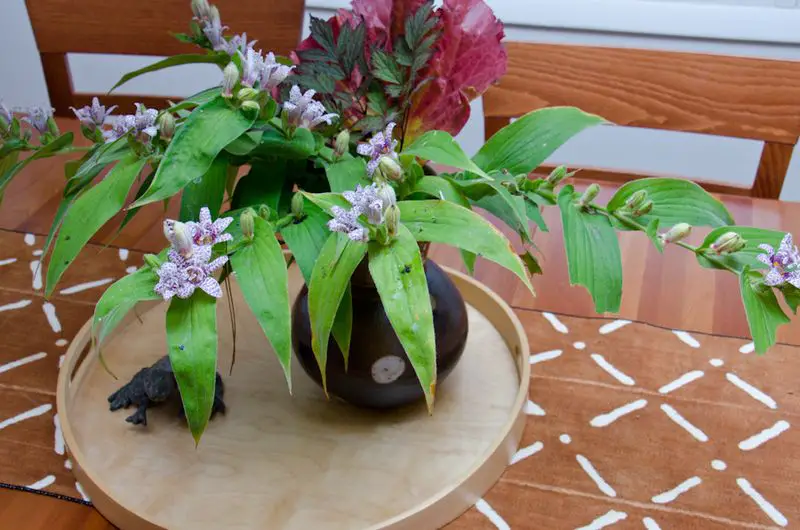
Toad Lilies are a unique and striking addition to shaded gardens, known for their orchid-like, spotted flowers that bloom in late summer to fall. These unusual blooms, which come in colors like white, purple, and lavender, offer a touch of elegance and intrigue to deeply shaded areas. Toad Lilies thrive in moist, well-drained soil and are perfect for brightening up the darkest corners of your garden when most other plants have finished blooming. Their late-season flowers make them an excellent choice for extending the beauty of your garden into the fall months.
Tips for Growing Toad Lilies:
- Soil: Toad Lilies thrive in rich, moist, and well-drained soil. They prefer slightly acidic to neutral soil, so amend the planting area with compost to enhance fertility and moisture retention.
- Watering: Keep the soil consistently moist, especially during dry periods, but avoid waterlogging. These plants love humidity and moisture but should not sit in soggy soil.
- Sunlight: Toad Lilies are ideal for areas with partial to full shade. While they can tolerate a bit of morning sunlight, they do best in spots where they are protected from the harsh midday sun.
- Mulching: A layer of mulch around the base of the plant will help retain moisture, keep the roots cool, and reduce competition from weeds.
With their exotic flowers and late-season bloom time, Toad Lilies are an exceptional choice among the 20 Best Plants For Shade. Their ability to thrive in deep shade and offer a burst of color during the fall makes them a standout in any shaded garden
15. Foamflower (Tiarella)
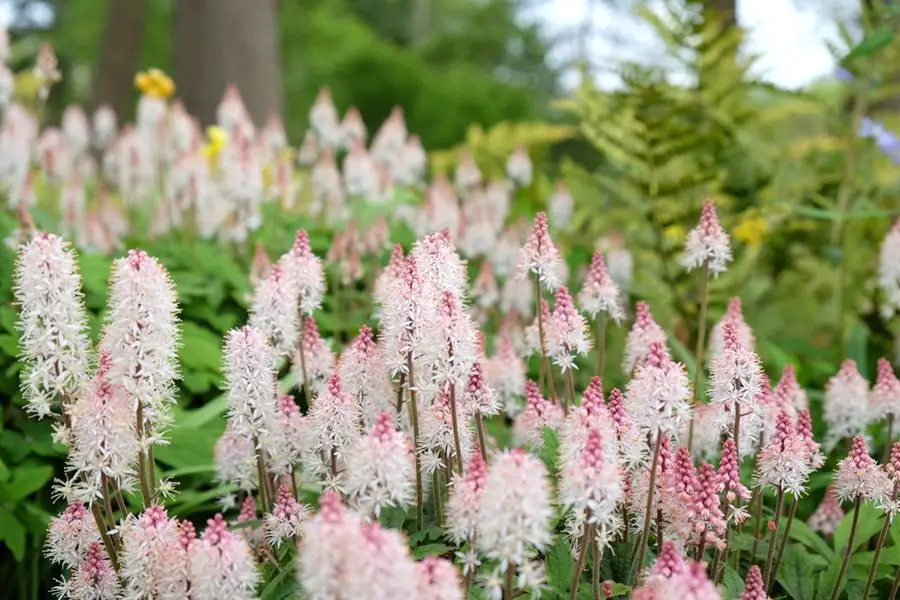
Foamflowers are a delightful addition to any shaded garden, known for their starry, feathery blooms and attractive heart-shaped leaves. These low-growing perennials produce delicate white or pink flowers on spiky, airy stems, creating a frothy appearance that adds charm and texture to shaded ground. Foamflowers are perfect for ground cover, as they spread easily and fill in bare spots with their lush foliage and cheerful blooms. They thrive in moist, well-drained soil and are an excellent choice for areas where other plants might struggle to grow.
Tips for Growing Foamflower (Tiarella):
- Soil: Foamflowers prefer moist, well-drained soil rich in organic matter. They thrive in slightly acidic to neutral soil, so adding compost can enhance soil fertility and moisture retention.
- Watering: Keep the soil consistently moist, especially during dry periods. Foamflowers are sensitive to drought, so regular watering is essential to keep the foliage lush and the flowers blooming.
- Sunlight: Foamflowers do best in partial to full shade. They tolerate some morning sun but should be protected from harsh afternoon heat, which can scorch their delicate leaves.
- Mulching: A layer of mulch will help keep the soil moist and prevent weed growth, which can compete with the plant’s roots.
With their elegant flowers and beautiful foliage, Foamflowers are a perfect choice for filling shaded areas and providing texture. As part of the 20 Best Plants For Shade, they are an excellent addition to any garden, bringing both beauty and functionality to low-light spaces.
16. Lamium (Dead Nettle)
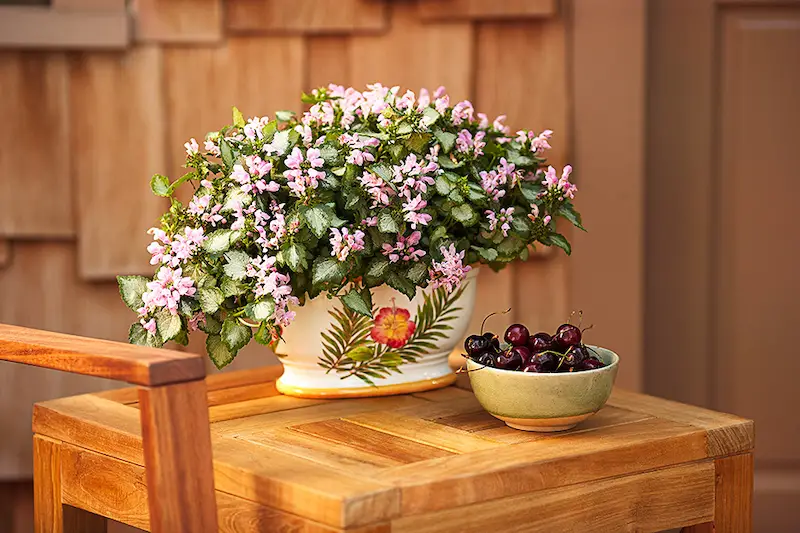
Lamium, commonly known as Dead Nettle, is a versatile and attractive ground cover that thrives in shaded areas. With its silvery foliage and delicate, tubular flowers in shades of white, pink, or purple, Lamium is a standout in woodland gardens or beneath trees where other plants may struggle. Its ability to spread quickly makes it an excellent choice for filling gaps in shaded spots, providing both texture and color throughout the growing season. Lamium is also known for its ability to tolerate a range of soil types, making it an easy-care addition to any low-light garden.
Tips for Growing Lamium (Dead Nettle):
- Soil: Lamium thrives in moist, well-drained soil, but it is tolerant of a range of soil types, including those that are slightly acidic to neutral. Adding organic matter like compost will enhance the soil’s fertility and moisture retention.
- Watering: Keep the soil evenly moist, but avoid overwatering, as Lamium can be prone to root rot in soggy conditions. During dry spells, regular watering will help keep it healthy and vibrant.
- Sunlight: Lamium excels in partial to full shade, making it perfect for woodland gardens or shady spots beneath trees. It can tolerate some dappled sunlight but should be protected from direct, intense sun.
- Mulching: Applying a layer of mulch helps retain moisture in the soil, especially during hot or dry periods, and prevents weed growth, which can compete with the plant.
With its attractive foliage and ability to quickly fill in shaded spaces, Lamium is an ideal choice for ground cover. It’s a standout among the 20 Best Plants For Shade, offering a beautiful and low-maintenance solution for shaded areas.
17. Anemones
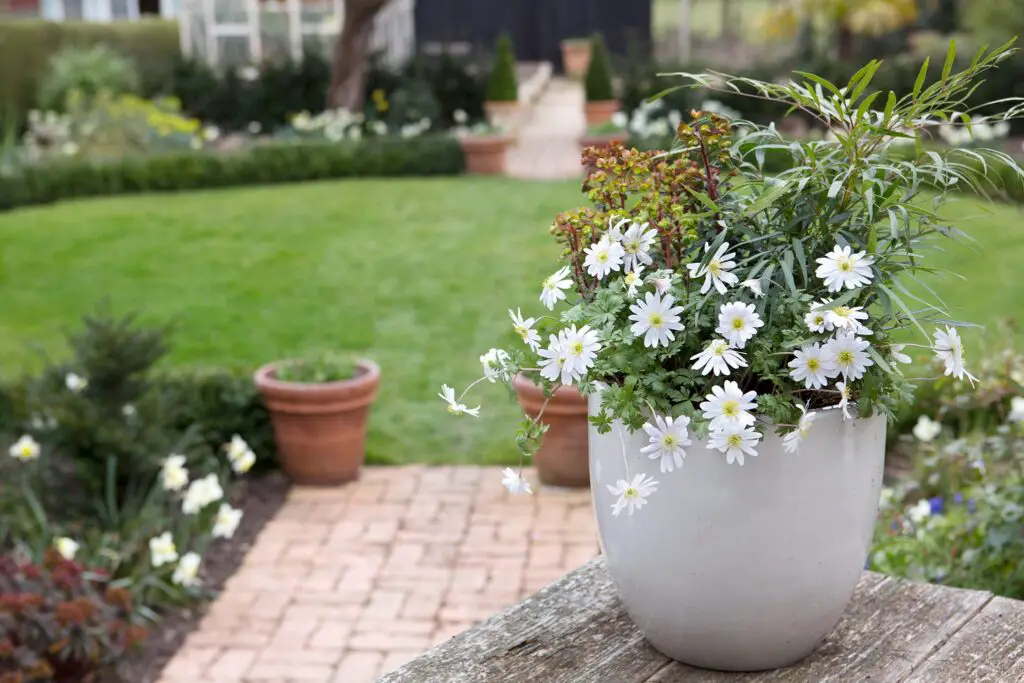
Anemones, also known as windflowers, are delicate yet striking perennials that thrive in partial shade, making them a wonderful addition to shaded garden spaces. These plants are prized for their cup-shaped flowers, which bloom in vibrant shades of pink, white, or purple. Anemones are known for their graceful, airy appearance and their ability to bring color and movement to shaded areas, especially in late spring to early fall. Whether planted along borders, in woodland gardens, or beneath taller plants, Anemones are perfect for brightening up your garden with their cheerful blooms.
Tips for Growing Anemones:
- Soil: Anemones prefer well-drained, slightly acidic to neutral soil. They thrive in moist soil enriched with organic matter, so adding compost will help retain moisture and promote healthy growth.
- Watering: Keep the soil consistently moist, but not soggy. Anemones need regular watering, especially during dry spells, but they do not tolerate standing water around their roots.
- Sunlight: These perennials do best in partial shade, though they can tolerate some morning sun. Too much direct sunlight can cause their blooms to wilt or fade too quickly, so providing them with a spot where they are protected from the harsh midday sun is ideal.
- Mulching: Mulching around Anemones helps retain moisture and keep the soil cool. It also helps prevent weeds from competing for nutrients and water.
With their delicate flowers and ability to thrive in partial shade, Anemones are a wonderful addition to the 20 Best Plants For Shade. Their vibrant blooms bring color and movement to your garden, making them a standout choice for shaded spaces.
18. Ajuga (Bugleweed)
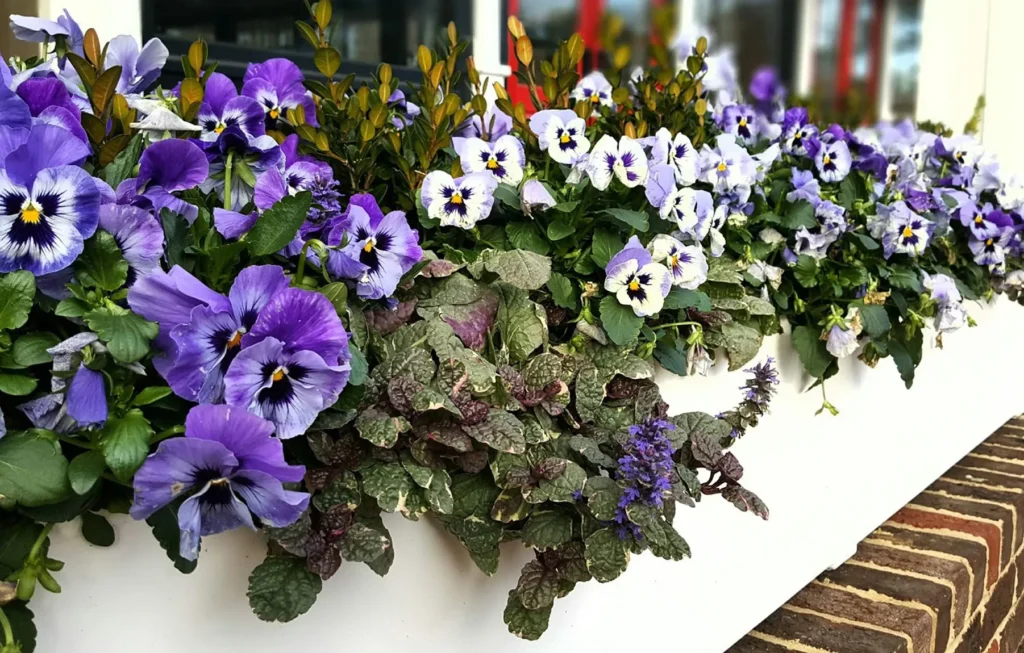
Ajuga, commonly known as Bugleweed, is a fast-growing, low-maintenance ground cover that thrives in shaded areas. Known for its striking deep blue or purple flower spikes, Ajuga adds a pop of color to otherwise dull, shady spots. Its evergreen foliage forms a dense mat that helps suppress weeds and provides year-round interest. Ajuga is perfect for covering the ground beneath trees, along garden edges, or in spots where grass may struggle to grow. This hardy plant not only offers vibrant blooms but also excellent ground coverage in shaded areas.
Tips for Growing Ajuga (Bugleweed):
- Soil: Ajuga prefers well-drained, slightly acidic to neutral soil. It can tolerate a variety of soil types but thrives in moist, rich soil with good organic content.
- Watering: Keep the soil consistently moist but not soggy. Ajuga is drought-tolerant once established, but regular watering is important, especially during dry periods.
- Sunlight: This plant excels in partial to full shade, making it an ideal ground cover for shaded gardens or areas beneath trees. While it can tolerate some morning sun, it thrives best in filtered light or dappled shade.
- Pruning: After the flowers have finished blooming, you can trim back the flower spikes and any excess growth to maintain a tidy appearance. Ajuga tends to spread quickly, so it’s a good idea to trim the edges if you need to contain its growth.
With its fast-spreading habit and vibrant flower spikes, Ajuga is an excellent choice for any garden in need of a reliable ground cover. As part of the 20 Best Plants For Shade, it’s a perfect solution for adding color and texture to shaded areas.
19. Pachysandra
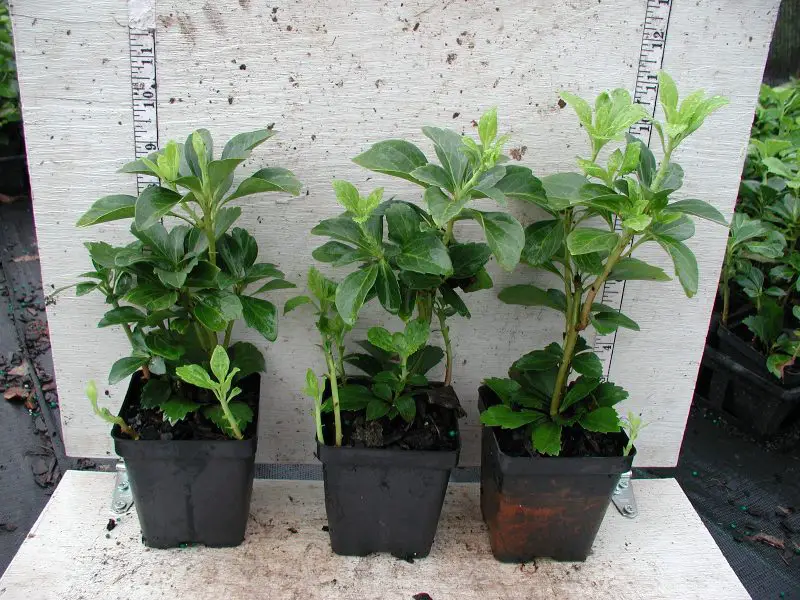
Pachysandra is a highly reliable, low-growing ground cover that thrives in tough, shady conditions. This evergreen plant is perfect for areas where other plants might struggle, as it tolerates deep shade and poor soil. Its glossy, dark green leaves provide year-round interest, making Pachysandra an excellent choice for creating a lush, vibrant ground cover in shaded gardens. Whether planted beneath trees, along garden edges, or in difficult-to-grow spots, Pachysandra ensures consistent beauty and greenery, even in the darkest corners of your garden.
Tips for Growing Pachysandra:
- Soil: Pachysandra thrives in rich, well-drained, slightly acidic to neutral soil. While it can tolerate poor soil conditions, it will perform best with ample organic matter. Adding compost can improve soil structure and moisture retention.
- Watering: Keep the soil consistently moist, especially during dry spells. While Pachysandra is fairly drought-tolerant once established, it still benefits from regular watering in hotter months.
- Sunlight: This ground cover excels in full to partial shade, making it perfect for shaded areas beneath trees or in spots with limited sunlight. It can tolerate some morning sun but prefers the cooler conditions of full shade.
- Maintenance: Pachysandra requires minimal maintenance, but it can spread quickly. Periodically check the edges of your planting areas and trim back any overgrowth to keep it under control.
With its evergreen nature and ability to thrive in challenging shaded conditions, Pachysandra is a standout among the 20 Best Plants For Shade. It’s an excellent choice for creating a lush, green ground cover that provides year-round beauty in shaded areas.
20. Hellebores (Lenten Roses)
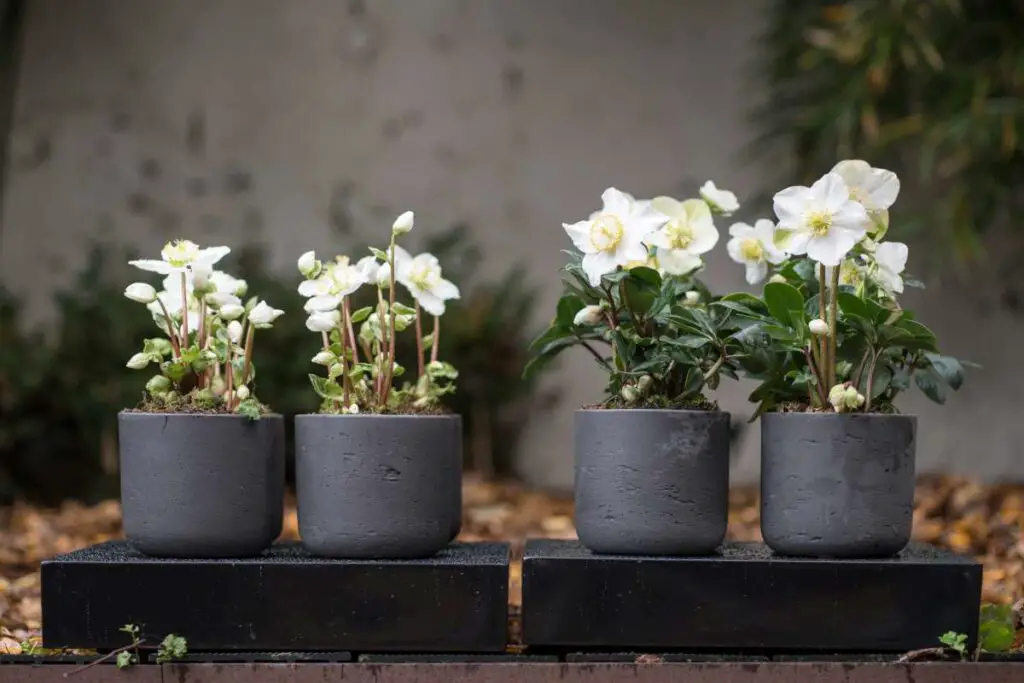
Hellebores, also known as Lenten Roses, are truly show-stopping shade plants that bloom in early spring, providing a much-needed splash of color when many other plants are still dormant. Known for their long-lasting, delicate flowers, Hellebores are available in a variety of colors, including white, pink, purple, and even green. Their leathery, evergreen foliage adds texture to shaded areas year-round, making them a fantastic addition to any garden. These resilient plants thrive in partial to full shade and are perfect for woodland gardens or shady spots where you want a touch of drama in early spring.
Tips for Growing Hellebores (Lenten Roses):
- Soil: Hellebores thrive in well-drained, slightly acidic to neutral soil. They prefer rich, loamy soil that retains moisture but isn’t soggy. Adding organic matter like compost can help improve soil structure and fertility.
- Watering: Keep the soil evenly moist, but ensure good drainage to prevent root rot. Hellebores are relatively drought-tolerant once established, but they will need regular watering during dry spells.
- Sunlight: These plants do best in partial to full shade, although they can tolerate some morning sun. Hellebores are excellent for shady spots where few other plants bloom early in the season, making them perfect for adding color to the garden during the colder months.
- Maintenance: After blooming, cut back any spent flowers and leaves to promote new growth. Hellebores do not require much pruning, but regular cleaning helps maintain their tidy appearance.
With their dramatic blooms and early-season color, Hellebores are a top pick in the 20 Best Plants For Shade. Their ability to thrive in the shade and offer striking flowers makes them a must-have for anyone looking to brighten up their shaded garden with a unique, low-maintenance plant.
With these 20 Best Plants For Shade, you can turn even the darkest corners of your garden into vibrant, lush landscapes. Whether you’re looking to brighten up shaded spaces, add texture, or introduce color, these plants offer a variety of options that will thrive in low-light conditions. From the bold foliage of Hostas to the delicate blooms of Hellebores, each plant adds its own unique charm to your garden.
Mix and match these varieties to create a dynamic and ever-changing garden that offers beauty throughout the year. Many of these plants offer a combination of colorful flowers, attractive foliage, and seasonal interest that will keep your shaded areas looking fresh and full of life, no matter the season.
Happy gardening!
FAQs:
1. What are the best plants for deep shade?
For areas with minimal sunlight, consider plants that are specifically known for thriving in deep shade, such as Hostas, Pachysandra, and Foamflower. These plants are well-suited for spots with little to no direct sunlight and will still provide lush foliage and beautiful blooms. Look for plants with bold, evergreen foliage or low-maintenance ground covers that can thrive in tough, shaded environments.
2. Can I plant flowers in shaded areas?
Absolutely! Many flowers thrive in shady environments. Some of the best shade-loving flowers include Astilbes, Bleeding Hearts, and Toad Lilies. These plants not only tolerate low light, but their blooms add color and texture to shaded spaces. Choose plants with long-lasting flowers and varying bloom times to ensure your garden has seasonal interest even in the shade.
3. How do I care for shade plants?
Shade-loving plants generally require moist, well-drained soil and regular watering, especially during dry spells. Be sure to avoid overwatering, as many shade plants do not tolerate soggy soil. It’s also important to choose plants suited for the amount of shade in your garden (partial or deep). Mulching can help retain moisture, suppress weeds, and keep the roots cool. Additionally, prune dead or spent flowers and foliage to encourage healthy growth.
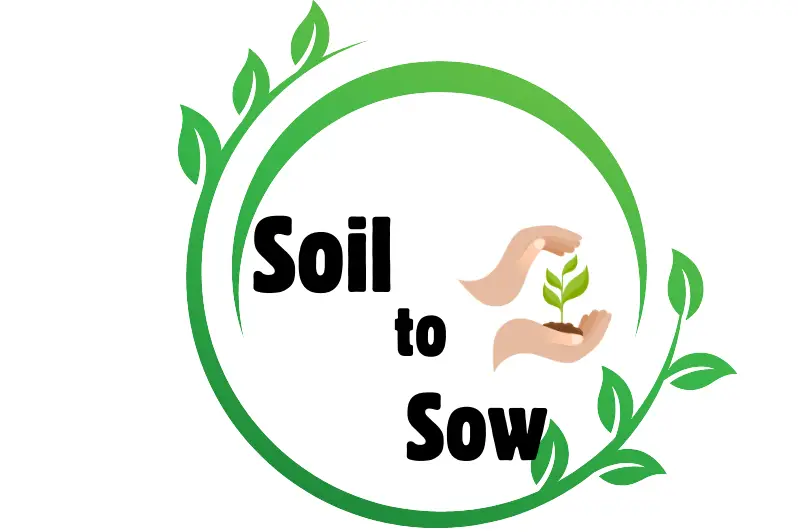

2 thoughts on “20 Best Plants For Shade: Brighten Your Dark Spaces!”